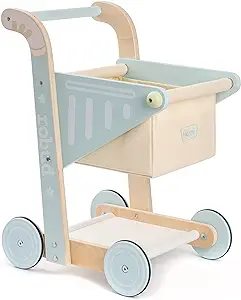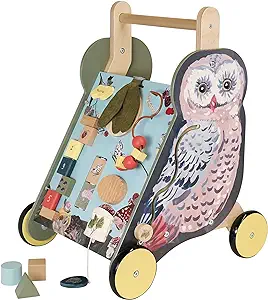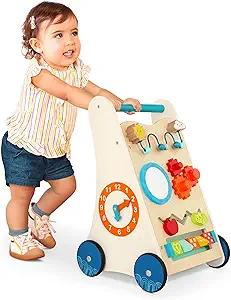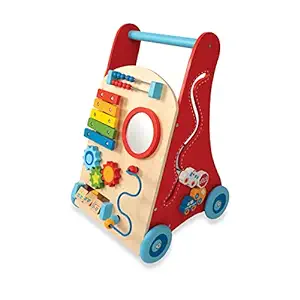
Table of Contents
Advantages of wooden baby walkers
Wooden baby walkers have been a staple in many homes for generations. They’re not just fun for kids. It also offers several development benefits. Let’s explore why choosing a wooden baby walker can be a wise choice for your child’s early years.
It stimulates physical development:
The capacity of wooden baby walkers to encourage children’s physical development is one of its key benefits. Children engage several muscle groups, such as the arms, legs, and feet, when they push themselves using a walker. This exercise enhances their coordination and muscle strength. It, at last, permits them to move freely.
It develops knowledge and skills:
In addition to physical development, wooden baby walkers also stimulate cognitive skills. As children navigate their environment using a walker, They learn about spatial awareness, cause and effect, and problem-solving. These mental challenges stimulate brain development and lay the foundation for future learning.
Environmentally friendly and safe:
Unlike their plastic counterparts, wooden baby walkers are often made of durable materials. This makes them an environmentally friendly choice for environmentally conscious parents. Additionally, wood-fired toys are generally free of harmful chemicals found in plastic toys, Which provides a safe play environment for your child.


Choosing the right wooden baby walker
When choosing a wooden baby walker for your baby, make sure that you make the best choice; some factors must be considered.
A strong-willed construction:
Look for a walker made of high-quality wood with solid construction. Ensure it can withstand your child’s weight and the rigors of everyday use without tipping over or falling off.
Safety features:
Safety should be a top priority when choosing a baby walker. Choose models with broad bases and rubberized wheels to prevent tipping and provide stability. Also, the safety certificate must be checked to ensure the walker meets industry standards.
Adjustability:
Select a walker that can be adjusted in height to suit your kid as they develop. Proper support and comfort are guaranteed when your child begins to walk, thanks to adjustable walkers.
The top wooden baby walkers on the market
There are nume ous wooden baby walkers available in the market. Each of them offers unique features and pros. The top
three options to consider are:

How to use a wooden baby walker
The wooden baby walker is easy to use. However, following the manufacturer’s instructions carefully is essential to ensure safe use.
The Directions of the Assembly:
Follow the instructions provided by the assembly to put the walker together correctly. Ensure all components are securely attached before allowing your child to use them.
Safety measures:
Always supervise your child using the walker and avoid stairs, uneven surfaces, and other hazards. Encourage your child to use a walker on flat surfaces for stability.
Tips for care and maintenance
Regular cleaning:
Use a moist towel to wipe the baby walker’s hardwood surfaces on a regular basis to get rid of spills, dust, and grime. Steer clear of abrasive cleaners and aggressive chemicals since they can harm w od.
Damage inspection:
Make sure to frequently check the wooden baby walker for indications of wear and tear, such as cracks, splinters, or missing parts. Fix any problems right away to guarantee the walker’s structural stability and security.
Tighten loose screws:
Check baby walker screws and fasteners on a regular basis to make sure they are securely tightened. Loose screws can jeopardize the stability of the walker and create safety hazards.
Apply wood polish:
To preserve the original beauty and integrity of the wood surfaces, use a light coat of wax or polish. Follow the manufacturer’s recommendations when applying polish to the wood in order to protect and nurture it.
Store indoors:
Avoid exposing the wooden baby walker for extended periods to high humidity, heat, or direct sunshine. Store the walker indoors in a dry a d climate-controlled environment to avoid breaking or damaging the wood when not in use.
Avoid overloading:
Avoid exposing the wooden baby walker for extended periods to high humidity, heat, or direct sunshine. Store the walker indoors in a dry a d climate-controlled environment to avoid breaking or damaging the wood when not in use.
Use on flat surfaces:
Make sure the wooden baby walker is used on flat and even surfaces to prevent tipping or instability. Avoid the use of walkers on uneven terrain or on surfaces with obstacles that can cause accidents.
Playtime monitoring:
Always monitor children when they are using a wooden baby walker to ensure their safety and prevent accidents. Encourage safe and responsible play by using a walker.
Check the wheels:
Check the baby walker’s wheels regularly to make sure they are clean, smooth, and free of debris. Lubricate the wheels, if necessary, to maintain smooth and easy movement.
Follow the manufacturer’s instructions:
Follow any maintenance and care guidelines provided by the manufacturer of the wooden baby walker. Following these guidelines will help increase the age of the walker and ensure safe use for your child.


Alternatives to wooden baby walkers
Although wooden children’s walkers offer many advantages, they may only suit some children or families. Below are some alternatives to consider.
Push toys:
Push toys, such as wooden or plastic wagons or carts, can provide support to children who are learning to walk. It also promotes balance and harmony.
Activity Centers:
Stationary activity centers with interactive toys, lights, and sounds can engage children and promote growth without the need for movement.
Stand-to-Stand-Walker:
Stand-to-stand walkers offer an assist set that allows children to sit and play before moving into a standing position when they are ready to walk.
Push walkers:
Stand-to-stand walkers offer an assist set that allows children to sit and lie before moving into a standing position when they are ready to walk.
Ride-on toys:
Ride-on toys, such as wooden or plastic scooters or rocking horses, allow children to find movement and balance in a fun and playful way.
Parent-assisted walking aids:
Parent-assisted walking aids, such as walking harnesses or handheld support bars, allow parents to assist their children’s walking efforts while ensuring safety and stability.
Crawl-through tunnel:
Crawl-through tunnel encourages children to explore movement and spatial awareness. as they crawl and maneuver through the tunnel.
Soft Playmates:
Soft playmates with cushioned surfaces provide a safe and comfortable environment for children to practice rolling, crawling, and, ultimately, walking.
Strong furniture:
Strong furniture, such as low tables or ottomans, can serve as a support for children. They pull themselves up while holding the furniture and travel along.
Outdoor play equipment:
Outdoor play equipment, such as kid-friendly slides, swings, and climbing structures, provides opportunities for children to develop gross motor skills and coordination in an outdoor environment.
Are wooden baby walkers safe for my baby?
Wooden baby walkers are generally considered safe for children. When used properly and under supervision. However, it is important to ensure that the walker meets safety standards, has wide bases, And has rubber wheels to prevent tipping over.
At what age can my child start using a wooden baby walker?
Most infants can be using a baby walker right away, age of 6 to 12 months, When they show signs of being ready for free movement. However, to determine whether your child is ready for growth, It is important to consult your pediatrician.
Do wooden baby walkers help my baby’s development?
Yes, wooden baby walkers can help with both physical and cognitive development. They promote muscle growth and coordination. When the kids get ahead of themselves, They also develop cognitive skills such as spatial awareness and problem-solving.
How do I choose the right wooden baby walker for my baby?
When choosing a wooden baby walker, consider factors such as strong construction, safety features such as wide bases and rubberized wheels, and adjustability to accommodate your baby’s growth.
Can wooden baby walkers be used on carpeted floors?
While wooden baby walkers are usually made for use on flats and even surfaces, They can be used on low-pile carpeted floors. However, it is important to ensure stability and closely monitor your child to prevent accidents.
Conclusion
There’s more to wooden baby walkers than play. They are useful resources for encouraging kids’ cognitive and physical growth. You may give your child hours of enjoyment and support them on their path to independent walking by selecting a strong and safe walker and adhering to these care and usage rules.
